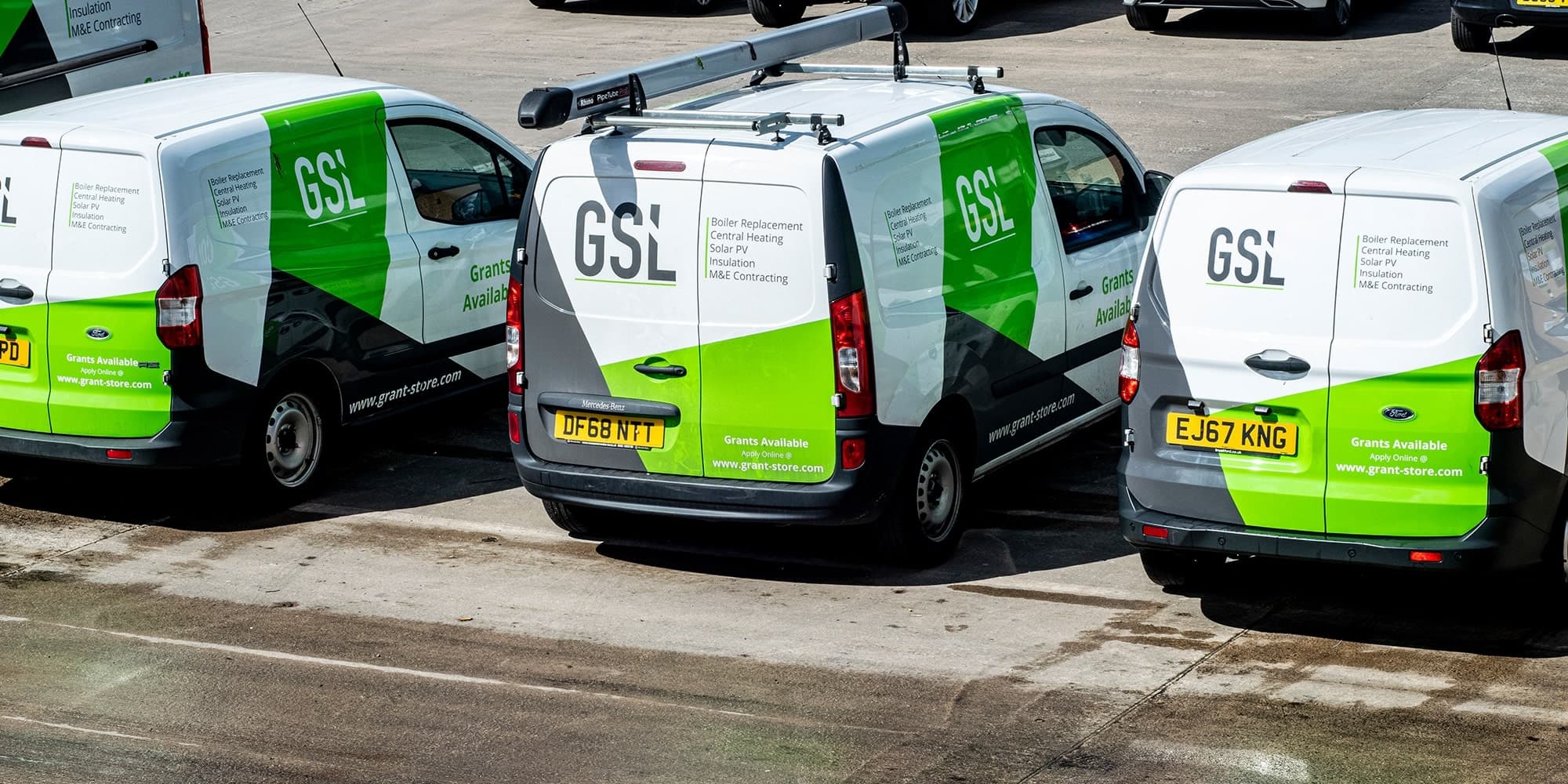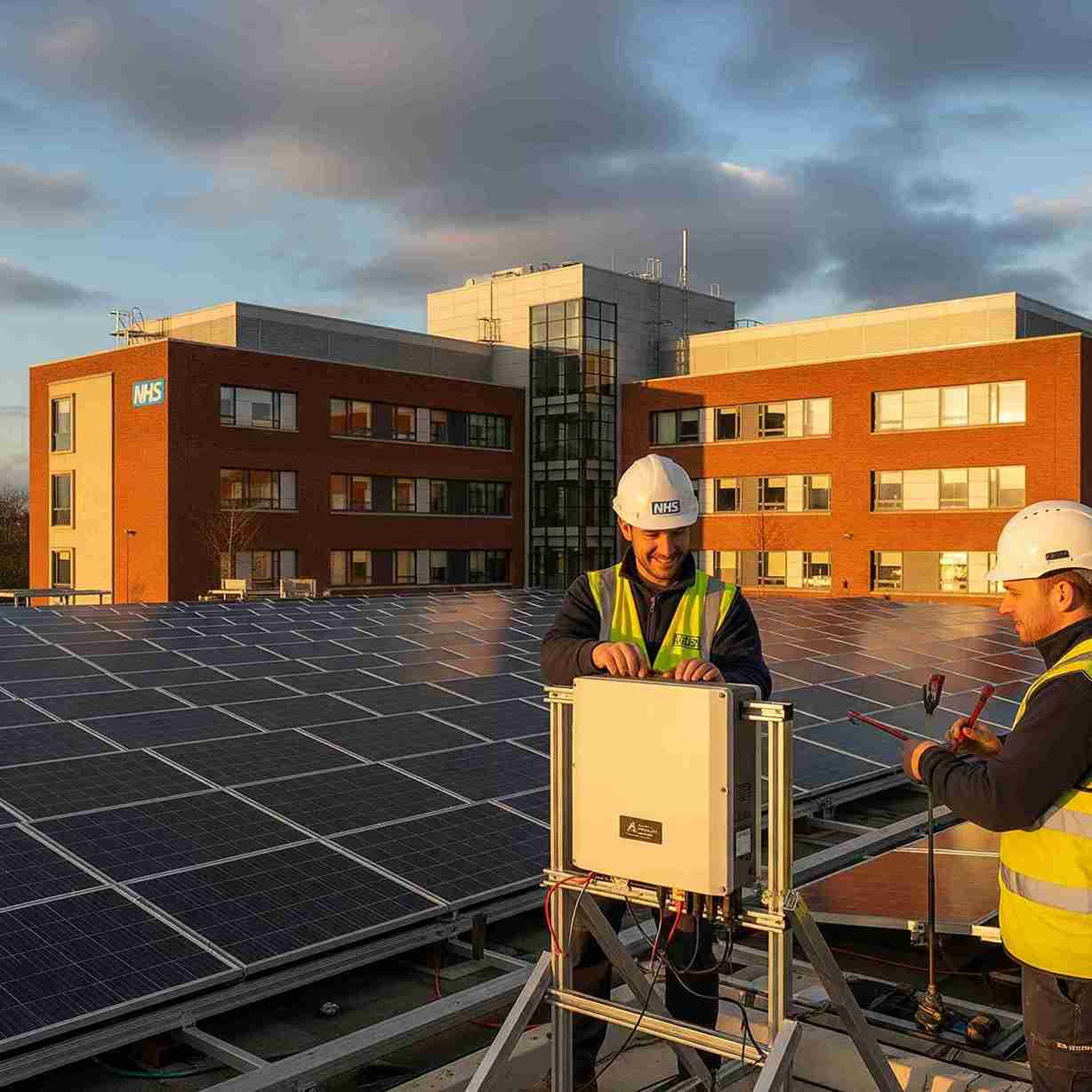August 6th, 2025
How 900m2 of solar panels are helping this NHS hospital go carbon neutral
Written by: Puneet Verma
News
A solar panel inverter is a key part of any solar system. It converts the electricity your panels generate into power your home can actually use. Without one, your solar setup won’t work.
In this guide, we’ll explain what an inverter does, how it works, the different types available, and how long they last.
Jump to:
A solar inverter is a device that converts direct current (DC) electricity generated by your solar panels into alternating current (AC) electricity, which powers your home.
Inverters are necessary in any solar panel system because most home appliances use AC power, not DC. Without an inverter, the energy your panels collect can’t be used to run your appliances.
Solar panels collect energy from sunlight and generate DC electricity, whereas solar inverters convert that DC electricity into usable AC electricity. In short:
A solar inverter works by taking the DC electricity from your solar panels and converting it into AC electricity through internal circuits. The inverter monitors the power flow and decides whether to send energy into your home, the solar battery storage, or the electrical grid.
This is known as conversion efficiency. A good inverter does this quickly and with very little energy loss.
Whether a solar inverter needs mains power depends on the type of inverter you have. Grid-tied inverters (the most common kind in UK homes) do require a connection to the mains, as they need to synchronise with the electric grid to work safely. Off-grid and hybrid inverters can work outside of the grid, as they rely on battery storage to supply power when there isn’t enough daylight.
There are several different types of inverters, each for different setups:
String inverters are the most common inverters in home solar systems. They connect a “string” of solar panels to a single inverter.
Central inverters are similar to string inverters but are built for much larger systems. You’ll typically find them in commercial or industrial installations like solar farms. They can handle higher capacity and manage several panel arrays at once, making them perfect for large-scale energy production.
Off-grid inverters are designed for properties that aren’t connected to the national grid. They work alongside battery storage to supply continuous power, day and night. They’re often used in remote locations and are built to manage solar input and stored energy without needing to rely on other sources of electricity.
Power optimisers are installed on each individual solar panel and are usually paired with a string inverter. Their main benefit is improving system performance when panels are facing different directions or are partially shaded. By managing the output of each panel independently, they help reduce the energy loss you’d get with a standard string system.
Yes, solar panels can run an inverter without a battery. In fact, most grid-tied solar systems work this way. The panel generates power during the day, the inverter converts it, and any excess energy is sent to the grid. However, without a solar battery (and emergency power supply), you won’t be able to store energy for use at night or during a power cut.
Thinking about going solar but not sure where to start? Speak to the team at Grant Store today – we’ll make sense of it all and help you get the best setup for your space. Get in touch now!
A hybrid solar inverter combines solar energy conversion and battery system management in one unit by:
It’s a great option if you want more control over your energy use and plan to add battery storage, either now or in the future.
Solar doesn’t need to be complicated. With the right inverter, you can power your home, cut costs, and reduce your reliance on the grid – and Grant Store can help you get it right from day one. Start now with your free quote!
Most solar inverters last 10 to 15 years, but some modern models come with warranties of up to 20 years, depending on the brand and usage. Factors that affect inverter lifespan include:
Because the inverter handles daily conversions and monitoring, it’s often the first component to wear out in a solar panel system. Regular checking and cleaning can help your solar inverter last even longer.
Yes, a solar inverter is worth it – because without one, your solar panels can’t power anything in your home. It’s the inverter that converts the sun’s DC electricity into usable AC electricity. Whether you’re connected to the national grid or using an off-grid system, the inverter makes your solar setup work.
August 6th, 2025
How 900m2 of solar panels are helping this NHS hospital go carbon neutral
Written by: Puneet Verma
News
August 6th, 2025
What is a solar panel inverter?
Written by: Puneet Verma
News
June 9th, 2025
Solar water heating vs solar PV: What’s right for you?
Written by: Gareth Whitehill
News
May 9th, 2025
Solar panel installation: Step-by-step guide for UK homes & businesses
Written by: Gareth Whitehill
News
April 9th, 2025
Are solar batteries worth it in the UK?
Written by: Gareth Whitehill
News
April 9th, 2025
What size solar battery do I need?
Written by: Gareth Whitehill
News
January 20th, 2025
Heat pumps vs. traditional heating: Which is right for your home?
Written by: Gareth Whitehill
Heat Pumps
January 13th, 2025
Do heat pumps work well in older homes?
Written by: Gareth Whitehill
Heat Pumps
January 6th, 2025
How do air source heat pumps work?
Written by: Gareth Whitehill
Heat Pumps
December 30th, 2024
Are air source heat pumps worth it in the UK climate?
Written by: Gareth Whitehill
News
December 23rd, 2024
Why are heat pumps taking over UK homes?
Written by: Gareth Whitehill
Heat Pumps
December 16th, 2024
Are heat pumps suitable for smaller homes?
Written by: Gareth Whitehill
Heat Pumps
September 25th, 2024
Grant Store are official sponsors of Chorley FC!
Written by: Gareth Whitehill
News
August 30th, 2024
Grant Store is an official Octopus Trusted Partner!
Written by: Gareth Whitehill
News
August 1st, 2024
How green is solar energy?
Written by: Gareth Whitehill
Solar
July 30th, 2024
How to insulate an old house
Written by: Gareth Whitehill
News
July 29th, 2024
What’s Involved in an Air Source Heat Pump Installation?
Written by: Gareth Whitehill
Heat Pumps
July 28th, 2024
A complete guide to heating water with solar power
Written by: Gareth Whitehill
Solar
July 25th, 2024
How To Make the Most Out of ECO4 Funding
Written by: Gareth Whitehill
News
July 23rd, 2024
Are UK homes getting any greener?
Written by: Gareth Whitehill
News
June 27th, 2024
Why should you choose an MCS installer for your heat pump project?
Written by: Gareth Whitehill
Heat Pumps
June 27th, 2024
When does ECO4 end, and what happens next?
Written by: Gareth Whitehill
News
June 11th, 2024
Exploring Energy Grants for Pensioners: A Guide to Lowering Your Energy Costs
Written by: Gareth Whitehill
News
June 11th, 2024
Do air source heat pumps work well with solar panels?
Written by: Gareth Whitehill
Heat Pumps
June 11th, 2024
Your Guide to Understanding Energy Performance Certificates (EPCs)
Written by: Gareth Whitehill
News
June 11th, 2024
What energy grants can I get on Universal Credit?
Written by: Gareth Whitehill
News
June 1st, 2024
Who qualifies for a boiler grant in the UK?
Written by: Gareth Whitehill
News
May 22nd, 2024
Is the UK Government Planning to Ban Gas Energy?
Written by: Gareth Whitehill
News
April 25th, 2024
Your Complete Guide To Off-Gas Property Grants in the UK
Written by: Gareth Whitehill
News
April 24th, 2024
What are electric storage heaters?
Written by: Gareth Whitehill
News
April 23rd, 2024
How To Improve Your Home’s EPC Rating: A Guide to Boosting Efficiency and Reducing Costs
Written by: Gareth Whitehill
News
April 23rd, 2024
What is the ECO Scheme, and how can it help me?
Written by: Gareth Whitehill
News
April 23rd, 2024
How to apply for the ECO4 Grant: Everything you need to know
Written by: Gareth Whitehill
News
April 18th, 2024
The Complete Guide to Heat Pumps: Benefits, Costs, Savings, and Efficiency
Written by: Gareth Whitehill
Heat Pumps
March 13th, 2024
What size solar PV system do I need?
Written by: Gareth Whitehill
Solar
February 27th, 2024
What grants are available for energy-saving?
Written by: Gareth Whitehill
News
November 24th, 2023
How Many Solar Panels Do I Need?
Written by: Gareth Whitehill
Solar
November 23rd, 2023
How Much Money Do Solar Panels Save?
Written by: Gareth Whitehill
Solar
November 22nd, 2023
How Are Solar Panels Made?
Written by: Gareth Whitehill
News
November 22nd, 2023
Do you need planning permission for solar panels?
Written by: Gareth Whitehill
News
November 22nd, 2023
How Much Do Solar Panels Cost?
Written by: Gareth Whitehill
News
November 22nd, 2023
How Do Solar Panels Work?
Written by: Gareth Whitehill
News
November 20th, 2023
Smart Export Guarantee Rates 2024
Written by: Gareth Whitehill
News
November 20th, 2023
Can I Add a Battery to my Solar System?
Written by: Gareth Whitehill
News
November 20th, 2023
How Do You Store Solar Energy?
Written by: Gareth Whitehill
News
October 3rd, 2023
Solar panels: are they worth the cost?
Written by: Gareth Whitehill
News
September 19th, 2023
How efficient are solar panels?
Written by: Gareth Whitehill
News
September 19th, 2023
Do solar panels boost home value?
Written by: Gareth Whitehill
News
September 19th, 2023
What are the pros and cons of solar panels?
Written by: Gareth Whitehill
News
Not sure which energy-saving solution is right for your home? Or do you have questions about grant eligibility? Our team has the answers. Give us a call and we'll help you figure everything out.
Call us now on:
01942 918 844
"*" indicates required fields
